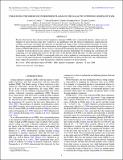| dc.contributor.author | Lopez, Laura A. | |
| dc.contributor.author | Pearson, Sarah | |
| dc.contributor.author | Ramirez-Ruiz, Enrico | |
| dc.contributor.author | Castro, Daniel | |
| dc.contributor.author | Yamaguchi, Hiroya | |
| dc.contributor.author | Slane, Patrick O. | |
| dc.contributor.author | Smith, Randall K. | |
| dc.date.accessioned | 2015-02-12T19:10:02Z | |
| dc.date.available | 2015-02-12T19:10:02Z | |
| dc.date.issued | 2013-11 | |
| dc.date.submitted | 2013-07 | |
| dc.identifier.issn | 0004-637X | |
| dc.identifier.issn | 1538-4357 | |
| dc.identifier.uri | http://hdl.handle.net/1721.1/94502 | |
| dc.description.abstract | Recent observations have shown several supernova remnants (SNRs) have overionized plasmas, where ions are stripped of more electrons than they would be if in equilibrium with the electron temperature. Rapid electron cooling is necessary to produce this situation, yet the physical origin of that cooling remains uncertain. To assess the cooling scenario responsible for overionization, in this paper we identify and map the overionized plasma in the Galactic SNR W49B based on a 220 ks Chandra Advanced CCD Imaging Spectrometer observation. We performed a spatially resolved spectroscopic analysis, measuring the electron temperature by modeling the continuum and comparing it to the temperature given by the flux ratio of the He-like and H-like lines of sulfur and argon. Using these results, we find that W49B is overionized in the west, with a gradient of overionization increasing from east to west. As the ejecta expansion is impeded by molecular material in the east but not in the west, our overionization maps suggest the dominant cooling mechanism is adiabatic expansion of the hot plasma. | en_US |
| dc.description.sponsorship | United States. National Aeronautics and Space Administration (NASA under contract NAS8–03060) | en_US |
| dc.description.sponsorship | Smithsonian Astrophysical Observatory (Contract SV3-73016) | en_US |
| dc.description.sponsorship | United States. National Aeronautics and Space Administration (Chandra Award Number GO2–13003A) | en_US |
| dc.description.sponsorship | David & Lucile Packard Foundation | en_US |
| dc.description.sponsorship | National Science Foundation (U.S.) (NSF grant AST–0847563) | en_US |
| dc.description.sponsorship | Massachusetts Institute of Technology (MIT Pappalardo Fellowship in Physics) | en_US |
| dc.description.sponsorship | United States. National Aeronautics and Space Administration (NASA, Einstein Fellowship Program, grant PF1–120085) | en_US |
| dc.language.iso | en_US | |
| dc.publisher | Institute of Physics/American Astronomical Society | en_US |
| dc.relation.isversionof | http://dx.doi.org/10.1088/0004-637x/777/2/145 | en_US |
| dc.rights | Article is made available in accordance with the publisher's policy and may be subject to US copyright law. Please refer to the publisher's site for terms of use. | en_US |
| dc.source | American Astronomical Society | en_US |
| dc.title | UNRAVELING THE ORIGIN OF OVERIONIZED PLASMA IN THE GALACTIC SUPERNOVA REMNANT W49B | en_US |
| dc.type | Article | en_US |
| dc.identifier.citation | Lopez, Laura A., Sarah Pearson, Enrico Ramirez-Ruiz, Daniel Castro, Hiroya Yamaguchi, Patrick O. Slane, and Randall K. Smith. “UNRAVELING THE ORIGIN OF OVERIONIZED PLASMA IN THE GALACTIC SUPERNOVA REMNANT W49B.” The Astrophysical Journal 777, no. 2 (October 23, 2013): 145. © 2013 American Astronomical Society. | en_US |
| dc.contributor.department | MIT Kavli Institute for Astrophysics and Space Research | en_US |
| dc.contributor.mitauthor | Lopez, Laura A. | en_US |
| dc.contributor.mitauthor | Castro, Daniel | en_US |
| dc.relation.journal | Astrophysical Journal | en_US |
| dc.eprint.version | Final published version | en_US |
| dc.type.uri | http://purl.org/eprint/type/JournalArticle | en_US |
| eprint.status | http://purl.org/eprint/status/PeerReviewed | en_US |
| dspace.orderedauthors | Lopez, Laura A.; Pearson, Sarah; Ramirez-Ruiz, Enrico; Castro, Daniel; Yamaguchi, Hiroya; Slane, Patrick O.; Smith, Randall K. | en_US |
| dc.identifier.orcid | https://orcid.org/0000-0002-3243-727X | |
| mit.license | PUBLISHER_POLICY | en_US |
| mit.metadata.status | Complete | |
